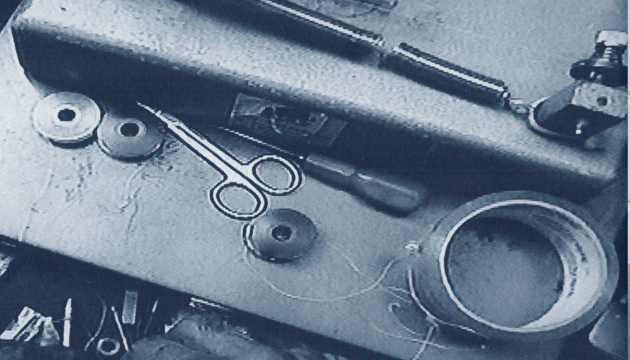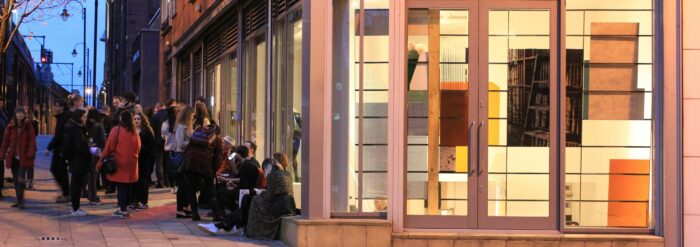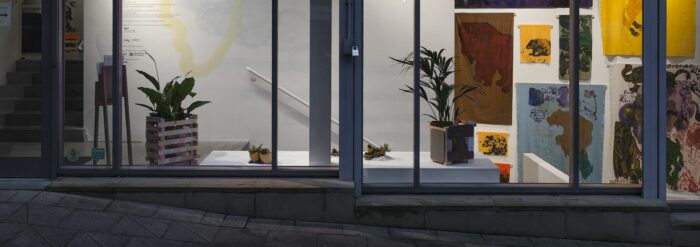
One and All Curated by Alison Kershaw
One and All Curated by Alison Kershaw
03 April 2009 - 17 May 2009
Grennan & Sperandio are well known for their socially engaged projects culminating in comic books. For their piece Specific Gravity they have developed a series of paintings produced by renderers in China of specific corners of Manchester, subtly manipulated digital images created by Grennan and Sperandio and then reproduced in oils.
Jo Lewington is interested in our experiences of time, space and movement. For One and All she researched the textile manufacturing industry and collaborated with workers in a factory on a video piece examining issues around time work and repetition. By focusing on the detail of their movements and on the visceral experience of work, Lewington considers our individual position within the wider networks of which we are part.
Jil Moore uses photography and found objects in her work Slapstick, a tryptich: Curly Larry, Mo consists of glass vessels containing mini scenes from transport systems to create imaginary architectural models. Moore looks at transport from an inner perspective – are we individuals or part of a collective consciousness led by the systems around us?
Hafsah Naib is interested in the ‘usefulness’ of the artist’s role in society and considers our relationship to object in the production of her work. Her piece TV was developed through an open call for redundant televisions which she uses as an interface to interview their previous owners about their relationship to the TV set as cultural icon.
Joe Richardson works with sculptural forms, light and text interventions to explore issues of power. For A Socio-organi-gram of CN4M and its environs, Richardson has mapped out the cultural links that exist between individuals in Manchester based on the impact of their role.
William Titley’s work looks at regeneration issues with local communities, sometimes borrowing the language and imagery of the regeneration industry. For Monument, Titley takes the galvanised steel dustbin and reworks it to create a sculptural piece protected within are microcosmic environments. But like the popular alley gate schemes that abound in our back streets, they are out of reach.
Andrew Wilson works as an artist and writer who uses technological media – text messaging and the internet. For his piece The Connections he has turned from his familiar realm of virtual networks to the concrete and has developed a Monopoly board game, the capitalist accumulation game.
One and All is curated by Alison Kershaw in collaboration with Castlefield Gallery.
More information at www.one-and-all.org
More on the artists:
Simon Grennan & Christopher Sperandio produce socially engaged projects culminating in a variety of media such as comic books, painting and sculpture. For their piece Specific Gravity they visited places that were described as significant by people who organise aspects of Community Network for Manchester. The final series of oil paintings were later produced by renderers in China based on the artists’ instructions. The artists explore what truth there might be in artistic expression in a global age of mass reproduction and how our experiences of place are mediated by systems of which we may not be aware. Grennan & Sperandio have exhibited extensively throughout the UK and Europe including the Hayward Gallery, Tate Modern, Baltic Centre for Contemporary Art, De La Warr Pavilion, South London Gallery, Ikon Gallery and Tate Liverpool, Palais de Tokyo, Paris; Arhus Kunstmuseum, Arhus, Denmark; Kunsthalle Wien, Vienna and Hasselblad Centre, Gottenburg, Sweden. They have also exhibited widely throughout the USA including Gallery HD Television/Jeffrey Deitch Gallery, New York and Museum of Modern Art/PS1, New York among other galleries. www.kartoonkings.com
Jo Lewington uses film and drawing to explore ideas that touch on movement, time, constraint and interdependence. Focusing on the detail of their routines and on the visceral experience of work, her research led to a video study of manufacturing work, made with workers in a local textiles factory, who wore head cameras to record each part of the process. Father on your right side, mother on your left reminds us of expectations that are pinned upon us through the demands of everyday life. The camera hovers over the work space, a volume of infinite potential which is only dependent upon our perception. Lewington studied Embroidery at MMU and has previously exhibited in venues around Manchester.
Jil Moore uses transparent materials such as glass, liquid and light in her work. In Slapstick, a tryptich: Curly Larry, Mo, she combines, for the first time, photographic imagery taken on route about Manchester’s travel network with layers of transparent materials. Looking at the ‘rush hour’ as a metaphor for networking and considering the experience of children and young people in her thinking about city travel, Moore is also looking at networks from an inner perspective – are we individuals or part of a collective consciousness led by the systems around us? Moore has previously exhibited around the UK.
Hafsah Naib is interested in the usefulness of the artist’s role in society and considers the relationship of objects in the production of her work. She often works with diverse groups including children, to distill ideas about how truth and knowledge are understood. Her piece TV was developed through an open call for redundant televisions which she uses as an interface to interview their previous owners about their relationship to the TV set as cultural icon. Naib has previous exhibited throughout the UK.
Joe Richardson works with sculptural forms, light and text interventions to question power structures. For A Socio-organi-gram of CN4M and its environs, Richardson has carried out an investigation of how the network operates by “surfing” through the various key contacts that different interviewees from the networks suggested. Using the kind of diagrams common in social research and science, Richardson has mapped out the cultural links that exist between individuals in Manchester based on the impact of their role. Drawn in pencil on a long roll of lining paper and placed on precious gold leafed pasting tables, the drawings are about to be obliterated by a sumptuous roll of blank red wall paper; the workings of the network are about to be hidden forever under this impressive decoration. Richardson is a member of the art and design collective UHC. www.uhc.org.uk .
William Titley looks at the effects of regeneration on local community groups; sometimes borrowing the language and imagery of the regeneration industry to explore ideas of location, identity and spatial ownership. For Monument he takes the galvanised steel dustbin and reworks it to create a sculptural piece protected within are microcosmic environments. But like the popular alley gate schemes that abound in our back streets, they are out of reach. The work pays homage to a relatively small number of individuals who, in the face of adversity, donate their time and energy to protect their neighbourhood and their community. Titley has exhibited throughout the UK at Manchester Art Gallery, Harris Museum and Art Gallery, Bloc Space and Static Gallery. He has also shown work at Zahoor ul Akhlaq Gallery, Lahore, Pakistan, The ConTEMPorary Gallery, New York; Museum of fine Arts, Ekaterinburg, Russia; National Centre for Contemporary Art, Moscow, Russia; Centre for Contemporary Art & Culture, Völklingen, Germany; Centre for Contemporary Art, Metz, France; New Media Installation, Galeria Biala, Lublin, Poland and BBK Video Festival: Kiel, Germany.
Andrew Wilson works as an artist and writer through the use of technological media such as text messaging and the internet. Realising the complexity of mapping the ‘social capital’ Wilson used analogue processes and face to face meetings to developed a board game that attempts to demonstrate how contacts and networks operate when community projects meet a dead end. Wilson is also co-director of Blink, a not-for-profit creative technology research organisation who have received awards including the Guardian’s text message poetry competition; City Poems in Leeds and Antwerp, the British Interactive Media Awards and Bluevend, shown in Tate Britain.
—
Alison Kershaw is an artist and independent curator. Her practice is based around long term relationships with particular places and people. She is interested in questioning who can be an artist today; where art can be experienced and why it is important. Her work is often created in collaboration with others, including artists, galleries, voluntary groups, individuals and organisations. She has been curating and coordinating exhibitions and projects since 1986, mainly within a small geographic area of Manchester, UK.

